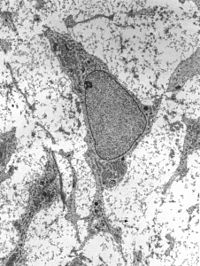
Photo from wikipedia
OBJECTIVES Hematopoietic stem cells (HSCs) reside in a specialised microenvironment in the bone marrow, which is majorly composed of mesenchymal stem cells (MSCs) and its' derivatives. This study aimed to… Click to show full abstract
OBJECTIVES Hematopoietic stem cells (HSCs) reside in a specialised microenvironment in the bone marrow, which is majorly composed of mesenchymal stem cells (MSCs) and its' derivatives. This study aimed to investigate the regulatory role of MSCs to decipher the cellular and humoral communications on HSCs' proliferation, self-renewal, and differentiation at the transcriptomic level. MATERIALS AND METHODS Microarray assay was employed to analyse the gene expression profile of HSCs that imparted by MSCs during co-culture. RESULTS The proliferation of human umbilical cord blood-derived HSCs (hUC-HSCs) markedly propagated when MSCs were used as the feeder layer, without disturbing the undifferentiated state of HSCs, and reduced the cell death of HSCs. Upon co-culture with MSCs, the global microarray analysis of HSCs disclosed 712 differentially expressed genes (DEGs) (561 up-regulated and 151 down-regulated). The dysregulations of various transcripts were enriched for cellular functions such as cell cycle (including CCND1), apoptosis (including TNF), and genes related to signalling pathways governing self-renewal, as well as WNT5A from the Wnt signalling pathway, MAPK, Hedgehog, FGF2 from FGF, Jak-STAT, and PITX2 from the TGF-β signalling pathway. To concur this, real-time quantitative PCR (RT-qPCR) was utilised for corroborating the microarray results from five of the most dysregulated genes. CONCLUSION This study elucidates the underlying mechanisms of the mitogenic influences of MSCs on the propagation of HSCs. The exploitation of such mechanisms provides a potential means for achieving larger quantities of HSCs in vitro, thus obviating the need for manipulating their differentiation potential for clinical application.
Journal Title: Gene
Year Published: 2022
Link to full text (if available)
Share on Social Media: Sign Up to like & get
recommendations!